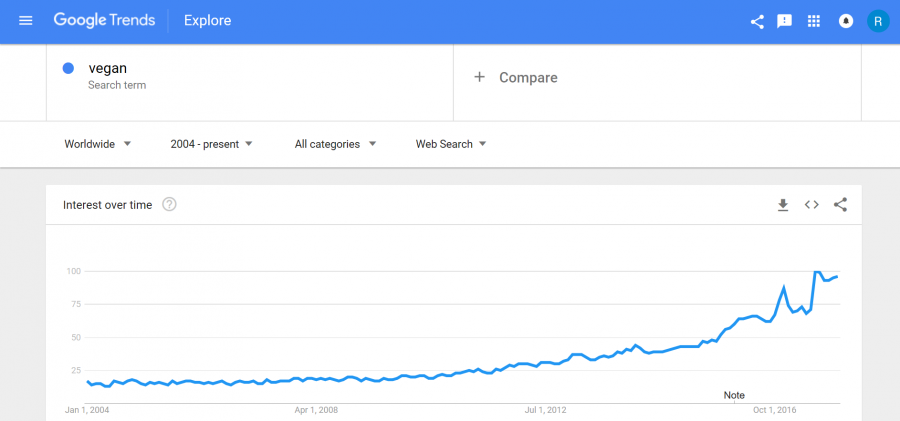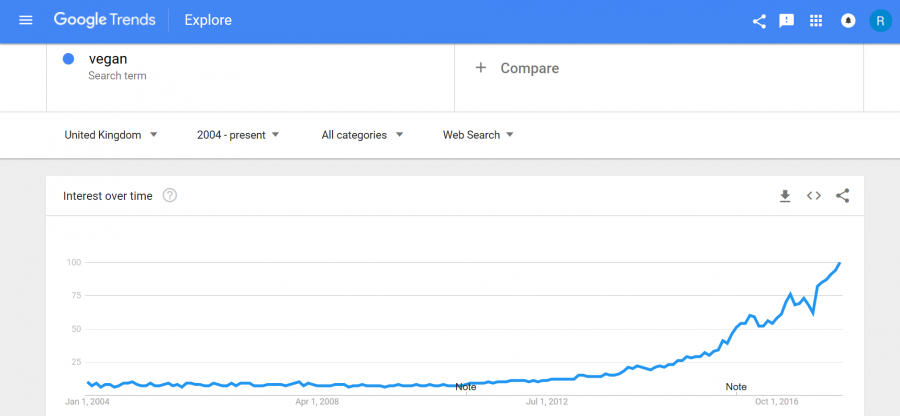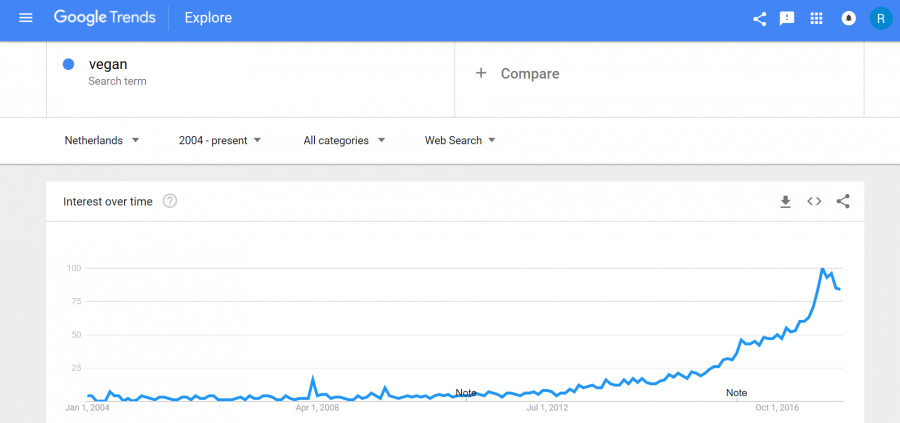
The Vegan lifestyle: how it went from rare to everywhere
Ten years ago, being a vegetarian and consuming no meat nor fish, was a difficult task. Having a vegan diet was even harder: products with no animal based ingredients that were also healthy and tasty were rare and extremely expensive.
These days, however, almost every restaurant in Western countries has at least one option on their menu that doesn't contain any animal products. This article explores the rise of veganism. I will concentrate on The Netherlands, and on how social media played an important part in this development. I will analyze this using the notion of the 'transnational culturescape' by Appadurai (1996) and Castells (2010).
Veganism: a definition
When someone lives as a vegan, they use no animal products in everyday life. On the website of the Vegan Society, the first formal vegan community to exist, the following definition is given:
“Veganism is a way of living which seeks to exclude, as far as is possible and practicable, all forms of exploitation of, and cruelty to, animals for food, clothing or any other purpose. (…) One thing all vegans have in common is a plant-based diet avoiding all animal foods such as meat (including fish, shellfish and insects), dairy, eggs and honey - as well as products like leather and any tested on animals.” (The Vegan Society)
The Vegan Society also states that vegans do not support animal exploitation for entertainment and thus try to avoid zoos or circuses that use animals. They also try to use medication that does not contain animal products like lactose or gelatin, but they do not exclude themselves completely from medicines that have been tested on animals. In many countries, like the Netherlands for instance, new drugs must be tested on a living animal before they can be considered “safe” and sold to the public (Rijksoverheid Nederland).
To understand this phenomenon, we have to look at its history. In order to understand veganism more fully, we need to look at when and where these communities emerged.
The history of veganism
The first traces of veganism can be found in the 19th century. The British doctor William Lambe and the poet Percy Bysshe Shelley were the first to give public opinions on not consuming dairy and eggs for ethical reasons. This was the start of “non-dairy vegetarians”, as the term veganism had not yet been coined.
The Vegan Society was founded by Donald Watson in November 1944. Donald Watson and his fellow non-dairy vegetarians were the ones who ultimately settled upon the term “vegan” (The Vegan Society). On September 8th 1978, the first Dutch organization for vegans, the “Veganistenkring”, was established. The organization later changed its name to the “Nederlandse Vereniging voor Veganisme (NVV)” in 1987 (Nederlandse Vereniging voor Veganisme).
The growing number of vegans
In a Western country like The Netherlands, no one can avoid seeing or dealing with veganism these days. Even though the first traces of the diet can be found in the early 1800s, veganism is more a product of 20th century Western culture (Arrpe, Mäkelä, Väänänen, 2011, p. 277).
Estimates of the current number of vegans are varied at best.. Very little research has been done regarding this matter. Moreover, veganism also comes in many forms. This means that people might not call themselves vegan, even though they do fit the definition stated above.
We could use the number of registered members of the Vegan Society for example, or the Dutch NVV, but not all vegans are members of organizations like these. I did contact the Dutch NVV to learn more about the current numbers of registered vegans in The Netherlands. According to Debby van Velzen, a promoter for the NVV, the last time the number of vegans in The Netherlands was researched was in 1996. That particular research found that there were around 16.000 vegans in The Netherlands. At that time, the NVV only had 439 members. Since then, the organization's number of members has grown immensely, according to Van Velzen, to 2.246 members at the beginning of 2017. All of this points to the conclusion that veganism is still growing in The Netherlands. (Van Velzen, personal communication, 2017).
"Even though the first traces of the non-diary diet can be found in the early 1800s, veganism is a real product of 20th century Western culture." (Arrpe, Mäkelä & Väänänen, 2011, p. 277)
As stated above, veganism began with the emergence of The Vegan Society in the United Kingdom as the animal rights movement, but has now become a cultural movement with a different message. When the American Vegan Society was founded in 1948, veganism really took off around the globe (Calvert, 2014, p. 12). This can be seen as a soft form of globalization, which is focused on cultural movements (Appadurai, 1996). This allowed for the emergence of an early transnational vegan “cultural scape” (Appadurai, 1996).
Calvert also explains that an increased interest in veganism started around 2011. This is confirmed by Google trends- a tool that shows the prevalence of a search term over time. The chart below shows the change in "interest over time" for the search term "vegan." Google explains “interest over time” as: “Numbers represent search interest relative to the highest point on the chart for the given region and time. A value of 100 is the peak popularity for the term. A value of 50 means that the term is half as popular. Likewise a score of 0 means the term was less than 1% as popular as the peak” (Google Trends).
I first decided to look at the scale “worldwide”, from the oldest date, which was 2004, up to now. The results show that July 2017 had the highest amount of searches including the term “vegan.”
These statistics show that the growing interest in veganism online started around 2010 (Google Trends, 2017). As mentioned before, according to Calvert, veganism started growing online in 2011. This is almost in accordance with the result from Google Trends worldwide.
When looking at the statistics for the United Kingdom, where The Vegan Society is based, we do indeed find that the growth started in 2011.
Finally, focusing on The Netherlands, we can see that here the growth of searches for vegan actually started around 2012, but already had a little peak in 2008.
From this we can conclude that especially online, the growth of veganism started in the last few years. This growth can be followed via online search statistics. We will now focus on how social media played a role in veganism going global.
The online community of vegans
The Internet can be seen as the main infrastructure of globalization; it is the thing that globalizes us. It globalizes us in that it increases the availability and accessibility of existing knowledge. In this case we are concerned with how knowledge about veganism is communicated.
“Communication infrastructures are decisive components of the process of mega-metropolitanization but they are not the origin of the process. Infrastructure of communication develops because there is something to communicate. It is the functional need that calls for the development of infrastructures.” (Castells, 2010, p.37)
Castells implies that we need something to communicate in order to develop a communication infrastructure fitted for it. The Internet functions as a communication infrastructure for knowledge on veganism not only through Google search results, as seen before, but also through the online community of vegans..
In our modern century, individualization has played a big role. Veganism is a good example of individualization, because restricting our diet can isolate us. On the other hand, going vegan brings a community of already existing vegans to you. This community is a strong and growing one, which fights for its rights and beliefs. This community is especially big and approachable online. I will focus on some of these online communities and analyze the scale on which they operate.
The Facebook Community
When we look at Facebook, typing in “veganism” leads to an incredible amount of search results.
Figure 4. Print screen of the Facebook results when searching for "veganism".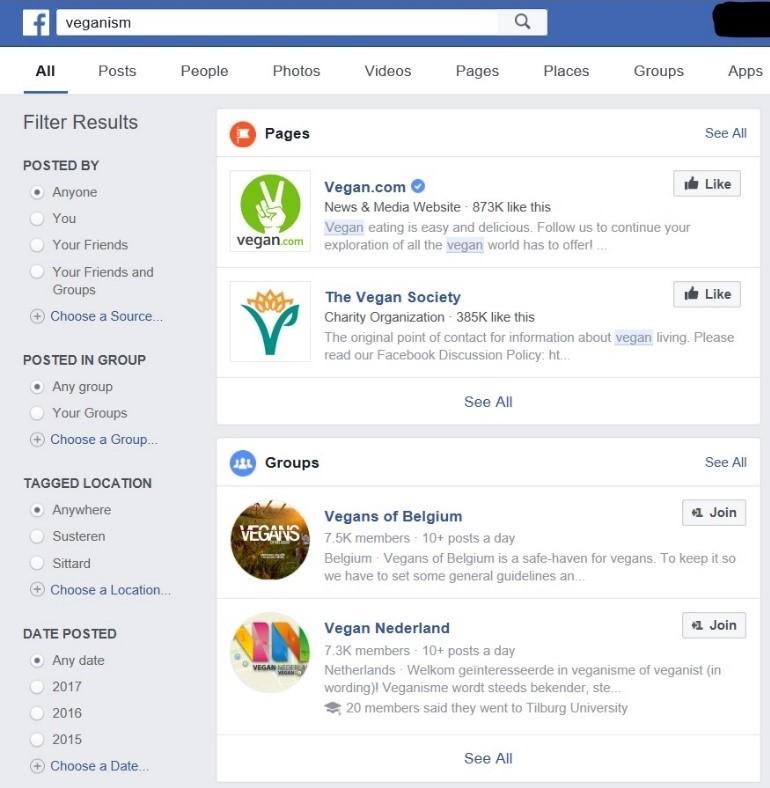
All kinds of pages show up, with different amounts of likes and engagement. The top result is the verified page @VeganDotCom, which has 873,950 likes and 848,585 followers. Looking at groups, we are shown groups from all around the world. Whether The Netherlands, Belgium, United Kingdom, or Chicago, all kinds of national and regional groups show up. Another type of group apart from regional ones, are worldwide groups targeted to another minority, like “Black Vegans speak”, “Vegan Moms and Babies” or even “Black Vegan Moms”.
Facebook has a large vegan community from all around the world. This community is fragmented into smaller “light communities”, which are communities that focus on a small ideal (Blommaert & Varis, 2015).
Pages such as “Black vegans” or “Vegan moms”, in which people identify as “black” as well as “vegan”, are examples of "light communities". They behave according to the standards for “black” as well as for the standards of “vegan”. These communities can be locally based, with national pages such as “Vegan Nederland”, as well as globally targeted, like the English page “Vegan.com”.
The Instagram Community
Food has become one of the main subject matters posted on social media. Instagram is one of the media platforms that is now famous for “foodstagram” pages, in which people share aesthetically pleasing pictures or videos of their food or how they made it. Searching for #Vegan leads to 51.437.070 posts with the #Vegan, and other posts with related hashtags, such as #vegansofig, #veganlunch or #veganfit.
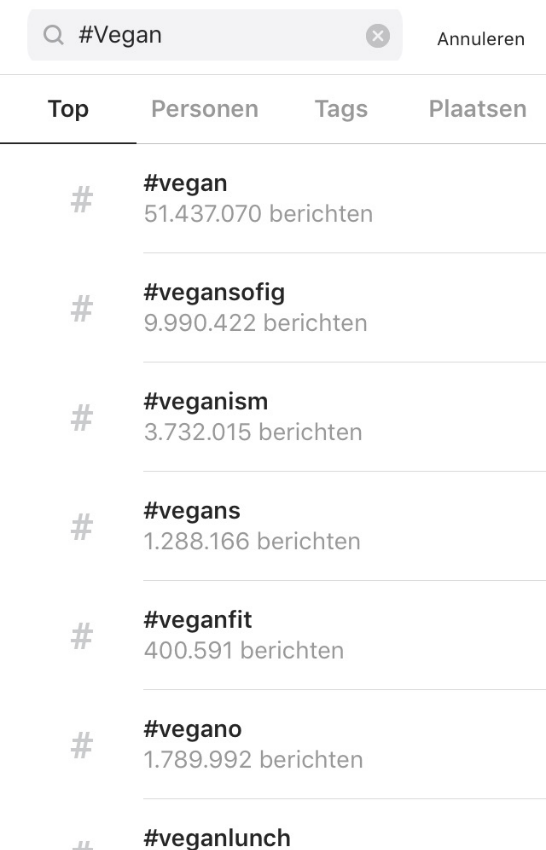
Figure 5. Print screen of the results on Instagram when searching for #Vegan
From these results we can conclude that vegan foodstagram is a global phenomenon. There are many vegan lifestyle accounts with tips and tricks or recipes. Also when we look at the Dutch #Veganisme, we find over 40,560 posts with this hashtag. When we look at accounts using this hashtag, many Dutch accounts show up, also with tips and tricks or vegan recipes. We can thus conclude that the vegan part of Instagram is a global, as well as local phenomenon, similar to Facebook's vegan communities.
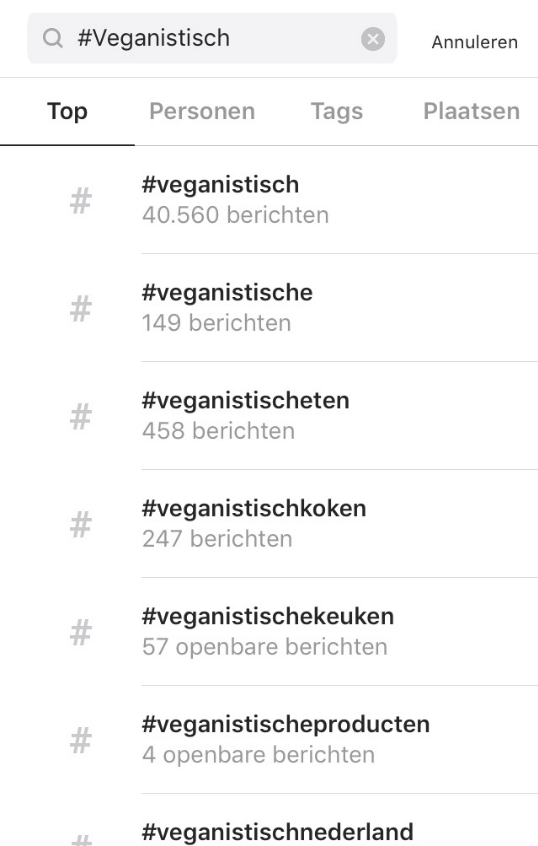
Figure 6. Print screen of the results on Instagram when searching for #Veganistisch
The Twitter community
Twitter is “the” social media platform of the hashtag. Searching for “vegan”, thus leads you to billions of posts with #vegan or something similar. It also leads you to many accounts that deal with veganism.
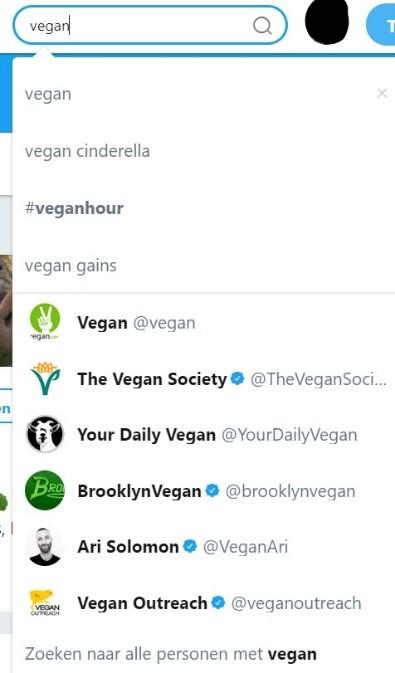
Figure 7. Print screen of the results on Twitter when searching "vegan"
It is notable that on Twitter we find less “local” accounts than on Facebook. This might be because you can follow pages on Twitter, but not join them, as with Facebook groups. We do see that many people from all around the globe tweet about veganism, with or without the #vegan. A global hashtag is most used, even in local tweets.
The YouTube Community
One of the other active online vegan “communities” is Vegan YouTube. Searching for “Veganism” on YouTube gives 6,7 million results. Scrolling through the results, most of the videos are in English.
Figure 8. Print screen of the YouTube results when searching "Veganism".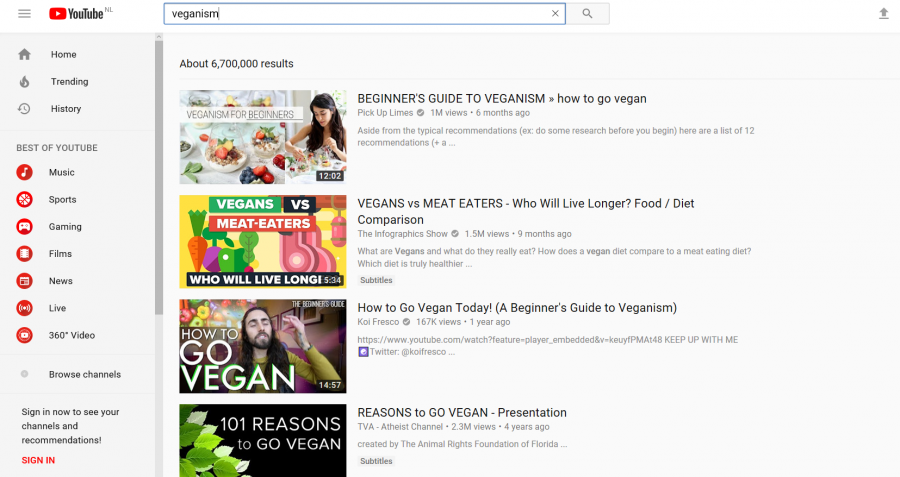
This is for global appeal, but when we dig in a little deeper, we can also find thousands of videos about veganism in other languages as well. When we search for “Vegan Nederland”, we find 8,620 results, most of which are in Dutch. Notably most of these videos are in Dutch, but have an English title.
This might also be for the global appeal, since almost all of these videos also provide the option to use English subtitles while watching the video. This is profitable for the creator of the video, since he or she is able to reach a broader audience, but it is also profitable for the viewer, as someone who cannot speak Dutch will also be able to watch these videos and explore worldwide ideas on veganism.
Figure 9. Print screen of the YouTube results when searching for "vegan nederland". 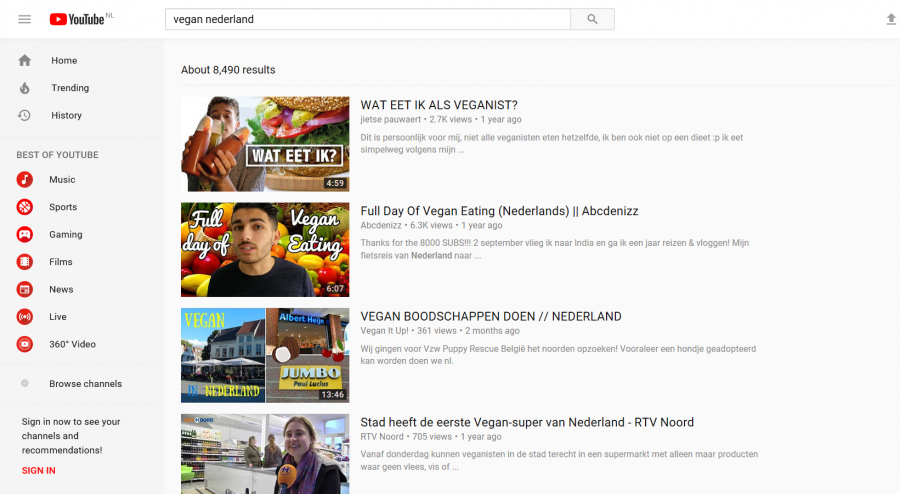
Just as with Facebook groups, YouTube videos or even entire accounts have different purposes or target different groups. There are thousands of videos that can be found on how to go vegan, reasons to go vegan, meat-lovers or other non-vegan people trying vegan food, even people trying vegan makeup, since cruelty free makeup is part of the vegan lifestyle too.
Another popular genre in the vegan YouTube Community is “food logs”, i.e. people explaining what they ate when and how this is as nutritious, tasty and healthy as non-vegan food. All these videos have different purposes, trying to appeal to different people. This also helps the globalization of veganism because it is very easy access diverse vegan content.
Veganism as a growing cultural phenomenon
As we have seen, from around 2010 on, veganism has grown enormously on a global as well local scale. While the movement has its roots in the 20th century., the Internet has helped this growth by being an infrastructure of communication as well as a source of knowledge. This knowledge is specified, as with social media targeted to specific groups, but also rather broad, as with general informational websites. We have seen that the internet has different online communities of vegans in which people communicate. These online communities are easy to find and have become very broad and common over the years. People living a 100% plant-based lifestyle might still seem a bit odd to omnivores, but they are less rare, and no longer eat only salads and fruits.
References
Appadurai, Arjun. (1996). Modernity at large: Cultural dimensions of globalization. University of Minnesota Press.
Arppe, T., Mäkelä, J., Väänänen, V. (2011). Living food diet and veganism: Individual vs collective boundaries of the forbidden. Social Science Information, 50(2), 275-297. doi:0.1177/0539018410396618
Blommaert, J. & P. Varis (2015). Enoughness, accent and light communities: Essays on contemporary identities. Tilburg papers in Culture Studies 139.
Van Velzen, D. (07-12-2017). Personal communication through email.
